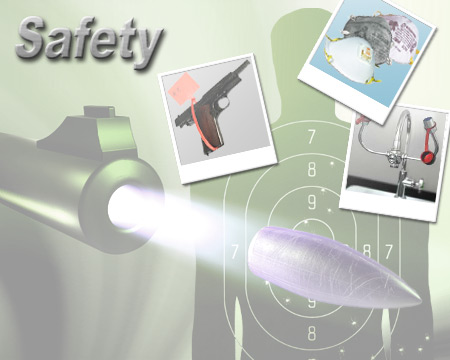Home | Glossary | Resources | Help | Contact Us | Course Map
Archival Notice
This is an archive page that is no longer being updated. It may contain outdated information and links may no longer function as originally intended.
| Author: John H. Dillon, Jr. |
| Jack Dillon earned a B. S. from the United States Naval Academy and an M. Ed. from the University of Virginia. Commissioned in the United States Marine Corps in 1964, he attained the rank of Captain of Marines. Appointed a Special Agent, FBI, in 1970, he investigated diverse criminal violations, including organized crime, bank robberies, extortions, and kidnappings. In 1976 he received orders to the Firearms/Toolmarks Unit of the FBI Laboratory for training as an examiner, where he evaluated evidence and provided on-site field support in domestic cases, as well as abroad. He also designed and taught basic and management-level forensic courses at the FBI Academy, Quantico, Virginia, 1982-1988. Jack retired from the FBI as Chief of the Firearms/Toolmarks Unit in 1994, and continues to consult in forensic firearm cases and in training design and delivery. |
Introduction
Safety is the first priority in conducting any laboratory examination. Laboratory safety protocols are implemented for the protection of all laboratory staff.
Safety procedures addressed in this module include
- firearms,
- biohazards,
- chemical.
| Note: |
| In any given laboratory, the safety protocols of that laboratory should be followed and will take precedence over any procedures outlined in this module or other modules. |
Objectives
At the conclusion of this module the student should be able to do the following:
- Summarize biohazard procedures generally, in regard to the importance of
- biohazard stickers,
- air drying bloody clothing and similar items,
- disinfectants for bullets,
- cleaning bullets bearing potential biohazards,
- particulate masks if appropriate,
- an awareness of possible parasites in clothing and other items.
- Describe chemical safety precautions relating to
- prevention of
- ingestion,
- inhalation,
- skin contact,
- reagent preparation,
- reagent storage,
- reagent marking,
- reagent disposal.
- prevention of
- Describe the rules for the safe handling of firearms-related evidence, including firearms, bullets, unfired ammunition, and blood-soaked clothing
- as they may apply to firearms in any circumstance,
- at a crime scene,
- upon receipt at the laboratory bench,
- during test firing,
- when using bullet recovery equipment,
- when firing known-distance gunshot residue patterns,
- in the courtroom.
- Articulate the appropriate safety precautions that should be taken in regard to toolmark-related evidence, including
- edged or pointed items (sharps),
- biohazards commonly encountered with edged tools.
- Provide an overview of firearms laboratory safety management and supervisory responsibilities, including these:
- Protection of personnel, to include
- general safety training,
- personal protective equipment,
- preventive health measures.
- Physical plant responsibilities, to include
- expendable supplies for evidence decontamination,
- lead abatement,
- ventilation,
- sound abatement.
- Emergency response preparation, to include
- planning concerns,
- emergency response training,
- emergency equipment,
- communications.
- Protection of personnel, to include
AFTE Knowledge and Ability Factors
| 130. | Knowledge of the potential hazardous properties of biological hazards (such as hepatitis, AIDS, etc.) |
| 131. | Knowledge of the potential hazardous properties of parasites. |
| 132. | Knowledge of the potential hazardous properties of toxic and reactive chemicals |
| 133. | Knowledge of the potential hazardous properties of gunshot residues |
| 134. | Knowledge of the proper methods for the handling and disposing of hazardous materials |
| 135. | Knowledge of how to safely handle potentially dangerous items, such as defective firearms, ammunition, and explosives for laboratory examination |
| 138. | Knowledge of the proper use of safety equipment and materials (such as protective clothing, eye and ear protective devices, and disinfectants) |
| 139. | Knowledge of safety procedures and the potential hazardous properties regarding test firing various firearms |
| 140. | Knowledge of safety procedures associated with the use of laboratory equipment |
| 141. | Knowledge of safety procedures associated with the use of handtools, woodworking machinery, and metalworking machinery |
| 94. | Ability to recognize unsafe conditions |
| 95. | Ability to employ safe work practices |
| 96. | Ability to render conditions safe |
Additional Online Courses
- What Every First Responding Officer Should Know About DNA Evidence
- Collecting DNA Evidence at Property Crime Scenes
- DNA – A Prosecutor’s Practice Notebook
- Crime Scene and DNA Basics
- Laboratory Safety Programs
- DNA Amplification
- Population Genetics and Statistics
- Non-STR DNA Markers: SNPs, Y-STRs, LCN and mtDNA
- Firearms Examiner Training
- Forensic DNA Education for Law Enforcement Decisionmakers
- What Every Investigator and Evidence Technician Should Know About DNA Evidence
- Principles of Forensic DNA for Officers of the Court
- Law 101: Legal Guide for the Forensic Expert
- Laboratory Orientation and Testing of Body Fluids and Tissues
- DNA Extraction and Quantitation
- STR Data Analysis and Interpretation
- Communication Skills, Report Writing, and Courtroom Testimony
- Español for Law Enforcement
- Amplified DNA Product Separation for Forensic Analysts



